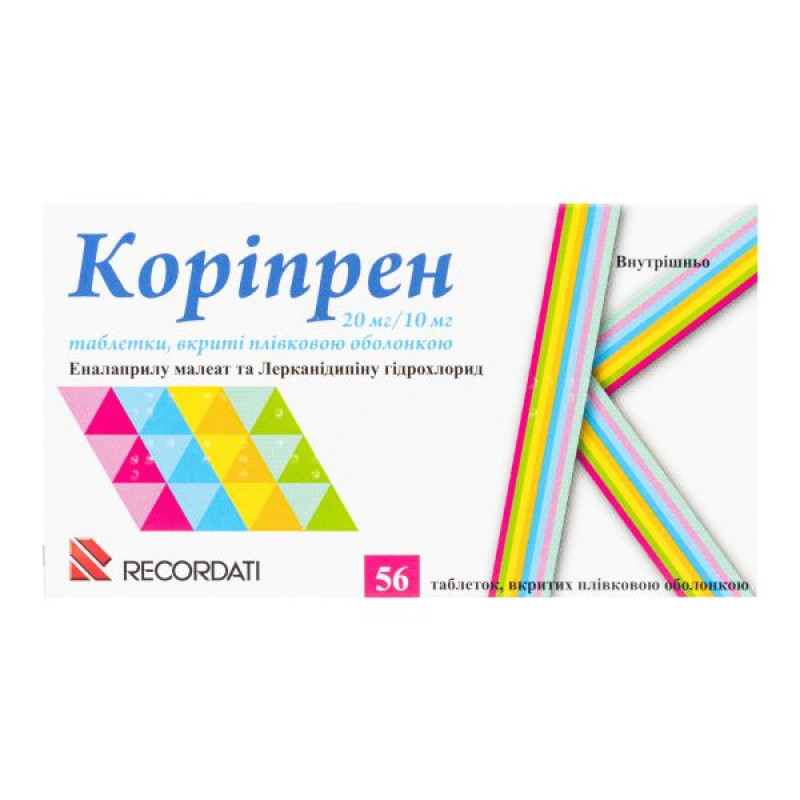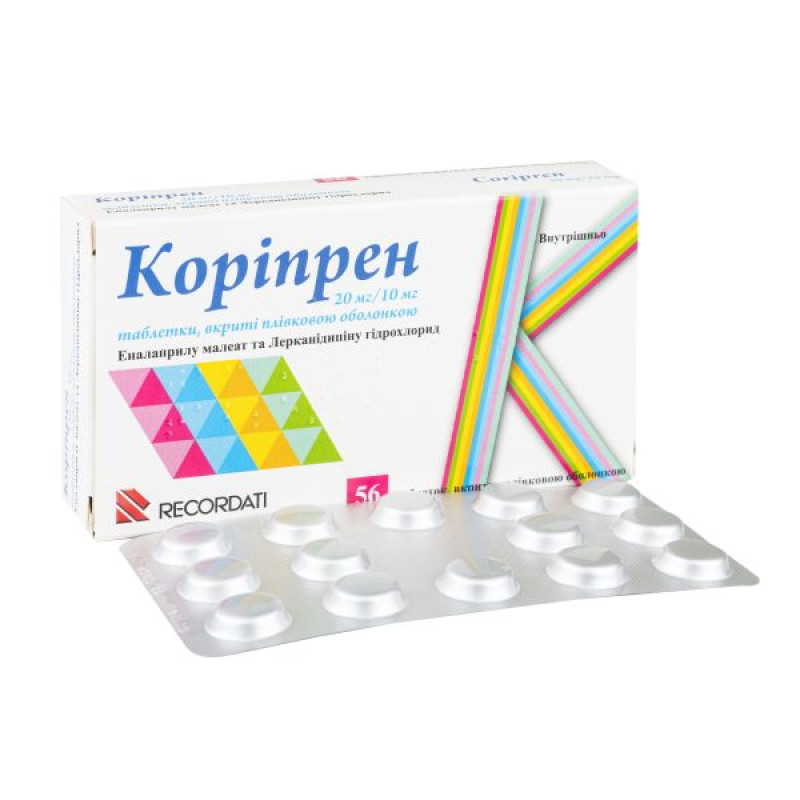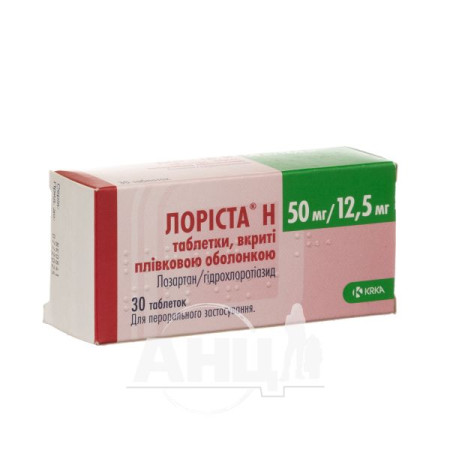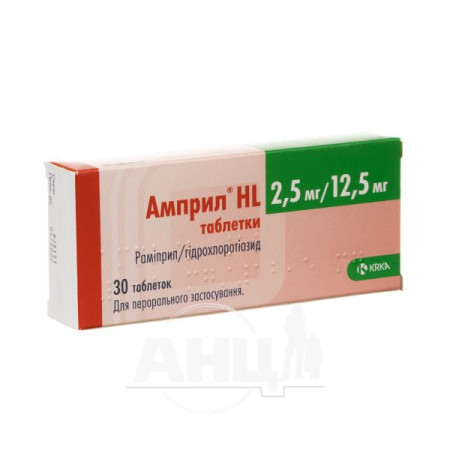Coripren 20 mg/10 mg film-coated tablets 20 mg + 10 mg blister No. 56
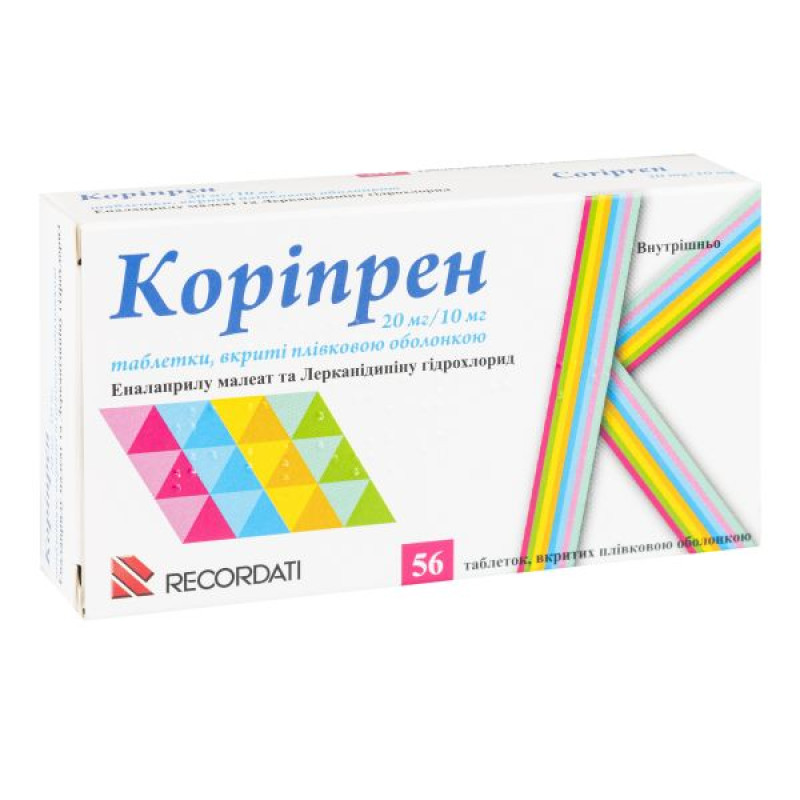
Instructions for use Coripren 20 mg/10 mg film-coated tablets 20 mg + 10 mg blister No. 56
Composition
active ingredients: enalapril; lercanidipine;
1 tablet contains enalapril maleate 20 mg (equivalent to enalapril 15.29 mg) and lercanidipine hydrochloride 10 mg (equivalent to lercanidipine 9.44 mg);
excipients: lactose monohydrate, microcrystalline cellulose, sodium starch glycolate (type A), povidone (K 30), sodium bicarbonate, magnesium stearate;
shell: yellow powder 02F22330;
contents of the yellow powder 02F22330: hypromellose 5cP (E 646), titanium dioxide (E 171), talc, macrogol 6000, quinoline yellow (E 104), iron oxide yellow (E 172).
Dosage form
Film-coated tablets.
Main physicochemical properties: yellow, round, biconvex, film-coated tablets.
Pharmacotherapeutic group
ACE inhibitors and calcium channel blockers: enalapril and lercanidipine.
ATX code C09B B02.
Pharmacological properties
Pharmacodynamics.
Coripren 20 mg/10 mg is a fixed combination of an ACE inhibitor (enalapril 20 mg) and a calcium channel blocker (lercanidipine 10 mg), two antihypertensive compounds with complementary mechanisms of action for the control of blood pressure in patients with hypertension.
In clinical trials, it was proven that the reduction in systolic blood pressure was more significant when using a fixed combination of enalapril and lercanidipine than when using either drug alone. The difference was 6.7 mm Hg.
In clinical trials, it was shown that the reduction in diastolic blood pressure was greater with the fixed combination of enalapril and lercanidipine than with either drug alone. The difference was 7.5 mm Hg.
Enalapril maleate is a salt of maleic acid and enalapril, a derivative of two amino acids - L-alanine and L-pyrrolidine-α-carboxylic acid. Angiotensin-converting enzyme (ACE) is a peptidyl dipeptidase that catalyzes the conversion of angiotensin I to the vasopressor agent angiotensin II. After absorption, enalapril is hydrolyzed to enalaprilat, which inhibits ACE. Inhibition of ACE leads to a decrease in plasma angiotensin II, which leads to an increase in plasma renin activity (due to the elimination of the negative feedback of renin release) and a decrease in aldosterone secretion. Since ACE is identical to kinase II, enalapril may also inhibit the degradation of bradykinin, a potent vasodepressor peptide. However, the role of this mechanism in the therapeutic effects of enalapril is still unknown.
Although the mechanism by which enalapril lowers blood pressure is thought to be primarily through suppression of the renin-angiotensin-aldosterone system, enalapril is hypotensive even in patients with low renin levels. Enalapril lowers blood pressure without a significant increase in heart rate in hypertensive patients in both the supine and standing positions. Symptomatic postural hypotension is rare. In some patients, it may require several weeks of treatment to achieve optimal blood pressure control. Abrupt withdrawal of enalapril does not result in a rapid increase in blood pressure.
Effective inhibition of ACE activity usually occurs 2-4 hours after a single oral dose of enalapril. The onset of the hypotensive effect was usually observed within one hour, with the maximum reduction in blood pressure occurring 4-6 hours after administration. The duration of action is dose-dependent, but at recommended doses the hypotensive and hemodynamic effects persist for at least 24 hours.
In hemodynamic studies of patients with essential hypertension, the reduction in blood pressure was accompanied by a decrease in peripheral arterial resistance with an increase in cardiac output and little or no increase in heart rate.
After enalapril administration, renal blood flow increases, while glomerular filtration rate remains unchanged. There is no evidence of sodium or water retention. However, in patients with low glomerular filtration rate before treatment, glomerular filtration rate usually increases.
After taking enalapril, a decrease in albuminuria and urinary excretion of IgG and total protein was observed in short-term studies in diabetic and non-diabetic patients with renal disease.
ACE inhibitors and angiotensin II receptor blockers should not be used concomitantly in patients with diabetic nephropathy.
Lercanidipine is a calcium antagonist of the dihydropyridine group and inhibits the transmembrane influx of calcium into cardiac muscle and smooth muscle. The mechanism of hypotensive action is based on a direct relaxing effect on vascular smooth muscle, which, thus, reduces total peripheral resistance. Despite its short half-life, lercanidipine has a prolonged hypotensive effect due to its high membrane partition coefficient and does not exhibit negative myotropic effects due to its high vascular selectivity.
As with other asymmetric 1,4-dihydropyridines, the hypotensive activity of lercanidipine is mainly due to its (S)-enantiomer.
Pharmacokinetics.
Pharmacokinetic interactions were not observed when enalapril and lercanidipine were co-administered.
Pharmacokinetics of enalapril
Absorption. Enalapril is rapidly absorbed; peak serum concentrations are observed within one hour. The extent of absorption of enalapril maleate after oral administration is approximately 60%. The presence of food in the gastrointestinal tract does not affect the absorption of enalapril.
Distribution. After absorption, enalapril is rapidly and extensively hydrolyzed to enalaprilat, a potent ACE inhibitor. Peak serum concentrations of enalaprilat occur 3 to 4 hours after an oral dose of enalapril maleate. The effective half-life for accumulation of enalaprilat after multiple doses of enalapril is 11 hours. In subjects with normal renal function, steady-state serum concentrations of enalaprilat are achieved after 4 days of treatment.
Within the entire therapeutic concentration range, 60% of enalaprilat binds to serum proteins.
Metabolism: Apart from conversion to enalaprilat, there is no evidence of significant metabolism of enalapril.
Excretion: Excretion of enalaprilat is primarily renal. The major components of urine are enalaprilat, which accounts for approximately 40% of the dose, and unchanged or metabolized enalapril (approximately 20%).
The half-life (T1/2) of enalapril with oral administration is 11 hours.
Renal impairment. Exposure to enalapril and enalaprilat is increased in patients with renal impairment. In patients with mild to moderate renal impairment (creatinine clearance 40-60 ml/min), steady-state AUC of enalaprilat is approximately two-fold higher than in patients with normal renal function after a 5 mg dose once daily. In patients with severe renal impairment (creatinine clearance ≤ 30 ml/min), AUC is approximately 8-fold higher. The effective half-life of enalaprilat after multiple doses of enalapril is prolonged at this level of renal impairment, and the time to reach steady-state is increased.
Enalaprilat can be removed from the circulation by hemodialysis. The dialysis clearance of enalaprilat is 62 ml/min.
Pharmacokinetics of lercanidipine
Absorption. Lercanidipine is completely absorbed after oral administration, with peak plasma levels achieved after approximately 1.5-3 hours. The two enantiomers of lercanidipine showed identical plasma level profiles: the time to peak plasma concentration is the same; both peak plasma concentration and AUC are on average 1.2 times higher for the (S)-enantiomer. The elimination half-lives of the two enantiomers are essentially the same. There is no interchangeability of the two enantiomers in vivo.
Due to the extensive first-pass metabolism, the absolute bioavailability of oral lercanidipine taken after a meal is approximately 10%. However, the bioavailability when taken by healthy volunteers on an empty stomach is reduced to 1/3 of the above value. The bioavailability of lercanidipine after oral administration increases 4-fold when taken no later than 2 hours after a high-fat meal. Therefore, the drug should be administered before meals.
Distribution: Distribution from plasma to tissues and organs is rapid and extensive.
Plasma protein binding exceeds 98%. Since protein levels are reduced in patients with severe renal or hepatic dysfunction, the content of free fractions of lercanidipine may be higher.
Metabolism: Lercanidipine is extensively metabolised by CYP3A4; no metabolites are detected in either urine or faeces. Lercanidipine is mainly converted to inactive metabolites and approximately 50% of the dose is excreted in the urine.
In vitro experiments with human liver microsomes have shown that lercanidipine exhibits a slight inhibition of the two enzymes CYP3A4 and CYP2D6 at concentrations 160 and 40 times higher than the peak plasma levels achieved after a 20 mg dose. In addition, an interaction study in humans has shown that lercanidipine does not modify the plasma levels of midazolam (a typical CYP3A4 substrate) or metoprolol (a typical CYP2D6 substrate). Therefore, it is expected that the use of lercanidipine at therapeutic doses will not lead to inhibition of the biotransformation of drugs metabolised by CYP3A4 or CYP2D6.
Excretion: Elimination is mainly by biotransformation.
The average terminal elimination time is estimated to be 8-10 hours. Due to the high affinity for lipid membranes, therapeutic activity lasts for 24 hours. Cumulation is not observed after repeated administration.
Special patient groups. The pharmacokinetics of lercanidipine in elderly patients and in patients with mild to moderate renal dysfunction or mild to moderate hepatic impairment have been shown to be similar to that observed in the general patient population. Patients with severe renal dysfunction or dialysis-dependent patients showed higher drug concentrations (approximately 70%). In patients with moderate and severe hepatic impairment, the systemic bioavailability of lercanidipine is probably increased, since it is mainly metabolised in the liver.
Indication
Essential hypertension.
Contraindication
Hypersensitivity to any angiotensin-converting enzyme (ACE) inhibitor or dihydropyridine calcium channel blocker or to any component of this medicinal product.
History of angioedema associated with previous treatment with ACE inhibitors.
Hereditary or idiopathic angioedema.
Pregnancy or planning pregnancy (see "Use during pregnancy or breastfeeding").
Left ventricular outflow obstruction.
Untreated congestive heart failure.
Unstable angina or recent (within 1 month) myocardial infarction
Severe renal failure (GFR <30 ml/min), including in patients on dialysis.
Severe liver failure.
Concomitant use:
strong CYP3A4 inhibitors;
cyclosporine;
grapefruit or grapefruit juice.
Concomitant use with sacubitril/valsartan therapy: Enalapril should not be administered earlier than 36 hours after the last dose of sacubitril/valsartan.
Concomitant use of Coripren 20 mg/10 mg with aliskiren-containing drugs in the presence of diabetes mellitus or renal insufficiency (GFR < 60 ml/min/1.73 m2).
Interaction with other medicinal products and other types of interactions
The hypotensive effect of Coripren may be potentiated by other drugs that lower blood pressure, such as diuretics, β-blockers, α-blockers, etc. In addition, the following interactions have been observed with the use of one of the components of the combination drug.
Enalapril maleate
Drugs that increase the risk of angioedema
Concomitant use of ACE inhibitors with sacubitril/valsartan is contraindicated as it increases the risk of angioedema.
mTOR inhibitors
Concomitant use of ACE inhibitors with racecadotril, mTOR inhibitors (e.g. sirolimus, everolimus, temsirolimus) and vildagliptin may lead to an increased risk of angioedema.
Dual blockade of the renin-angiotensin-aldosterone system (RAAS)
Clinical trial data have shown that dual blockade of the renin-angiotensin-aldosterone system (RAAS) through the combined use of ACE inhibitors, angiotensin II receptor blockers or aliskiren is associated with a higher incidence of adverse effects, including hypotension, hyperkalemia and renal impairment (including acute renal failure) compared with the use of a single RAAS-acting agent.
Potassium-sparing diuretics, potassium supplements, or potassium-containing salt substitutes
Serum potassium is usually normal, but hyperkalemia may occur in some patients taking enalapril. Potassium-sparing diuretics (e.g. spironolactone, eplerenone, triamterene or amiloride), potassium supplements or salt substitutes containing potassium may lead to significant increases in serum potassium. Caution should be exercised when enalapril is administered concomitantly with other agents that increase serum potassium, such as trimethoprim and co-trimoxazole (trimethoprim/sulfamethoxazole), since trimethoprim is known to act as a potassium-sparing diuretic to amiloride. Therefore, the combination of enalapril with the above-mentioned drugs is not recommended. If concomitant use is indicated, caution and frequent monitoring of serum potassium are necessary.
Cyclosporine Hyperkalemia may occur when ACE inhibitors are used concomitantly with cyclosporine. Monitoring of serum potassium is recommended.
Heparin Hyperkalemia may occur when ACE inhibitors are used concomitantly with heparin. Monitoring of serum potassium is recommended.
Diuretics (thiazide or loop diuretics)
The use of high doses of diuretics at the beginning of enalapril treatment may lead to a decrease in circulating blood volume and the risk of hypotension. Hypotensive effects can be reduced by discontinuing the diuretic, increasing water or salt intake, or using low doses of enalapril.
Other antihypertensive agents
Lithium Reversible increases in serum lithium concentrations and toxicity have been observed during concomitant use of lithium with ACE inhibitors. Concomitant use of thiazide diuretics with ACE inhibitors may lead to increases in lithium levels and an increased risk of lithium toxicity. Concomitant use of enalapril with lithium is not recommended, but if the combination proves necessary, careful monitoring of serum lithium levels should be performed.
Tricyclic antidepressants/antipsychotics/anesthetics/narcotics
Concomitant use of certain anesthetics, tricyclic antidepressants, and antipsychotics with ACE inhibitors may lead to a further decrease in blood pressure.
Nonsteroidal anti-inflammatory drugs (NSAIDs), including selective cyclooxygenase-2 (COX-2) inhibitors
Non-steroidal anti-inflammatory drugs (NSAIDs), including selective cyclooxygenase-2 (COX-2) inhibitors, may reduce the effect of diuretics and other antihypertensive drugs. Therefore, the antihypertensive effect of angiotensin II receptor antagonists or ACE inhibitors may be attenuated by NSAIDs, including selective COX-2 inhibitors.
The combined use of NSAIDs (including COX-2 inhibitors) and angiotensin II receptor antagonists or ACE inhibitors causes an additive effect on the increase in serum potassium and may lead to deterioration of renal function. These effects are usually reversible. Rarely, acute renal failure may occur, especially in patients with impaired renal function (e.g. the elderly or patients with dehydration, including those who are receiving diuretic therapy). Therefore, the combination of these drugs should be prescribed with caution to patients with impaired renal function. Patients should be adequately hydrated and special attention should be paid to monitoring renal function after initiation of concomitant therapy and periodically during treatment.
Gold preparations
Rarely, patients receiving injectable gold preparations (sodium aurothiomalate) and concomitant therapy with ACE inhibitors, including enalapril, have experienced nitritoid reactions (symptoms include facial flushing, nausea, vomiting, and hypotension).
Sympathomimetics Sympathomimetics may reduce the antihypertensive effects of ACE inhibitors.
Antidiabetic drugs
Epidemiological studies have shown that the combined use of ACE inhibitors and antidiabetic medicinal products (insulin, oral hypoglycaemic agents) may lead to an increased glucose-lowering effect with a risk of hypoglycaemia. This phenomenon is more likely during the first weeks of combined treatment and in patients with renal insufficiency.
Alcohol Alcohol enhances the hypotensive effect of ACE inhibitors.
Acetylsalicylic acid, thrombolytics and b-blockers
Enalapril can be safely taken simultaneously with acetylsalicylic acid (in cardiological doses), thrombolytics, and b-blockers.
Lercanidipine
Concomitant use contraindicated
CYP3A4 inhibitors
Lercanidipine is known to be metabolized by the CYP3A4 enzyme, therefore concomitant use of CYP3A4 inhibitors and inducers may affect the metabolism and elimination of lercanidipine.
An interaction study with ketoconazole, a strong CYP3A4 inhibitor, demonstrated a marked increase in plasma levels of lercanidipine (15-fold increase in the area under the concentration-time curve (AUC) of the drug and 8-fold increase in Cmax of the S-lercanidipine eutomer).
The combined use of lercanidipine with strong CYP3A4 inhibitors (e.g. ketoconazole, itraconazole, ritonavir, erythromycin, troleandomycin) should be avoided.
Cyclosporine When lercanidipine and cyclosporine were used together, an increase in the plasma concentration of both drugs was observed. A study in healthy young volunteers showed no change in plasma levels of lercanidipine after taking cyclosporine 3 hours after lercanidipine, but the AUC of cyclosporine increased by 27%. However, the combined use of lercanidipine with cyclosporine caused a 3-fold increase in plasma levels of lercanidipine and an increase in the AUC of cyclosporine by 21%.
Cyclosporine and lercanidipine should not be taken simultaneously (see section "Contraindications").
Grapefruit or grapefruit juice
As with other dihydropyridines, the metabolism of lercanidipine may be inhibited by grapefruit juice, leading to increased systemic availability and, consequently, increased hypotensive effect.
Lercanidipine should not be taken with grapefruit or grapefruit juice (see section "Contraindications").
Concomitant use is not recommended.
CYP3A4 inducers
The concomitant use of lercanidipine with CYP3A4 inducers such as anticonvulsants (e.g. phenytoin, carbamazepine) and rifampicin requires caution, as the antihypertensive effect of lercanidipine may be reduced. Therefore, blood pressure should be monitored more frequently than usual.
Alcohol Alcohol consumption should be avoided as it may enhance the effect of antihypertensive vasodilators.
Precautions for use, including dose selection
Caution should be exercised when co-administering lercanidipine with other CYP3A4 substrates such as terfenadine, astemizole, class III antiarrhythmic drugs such as amiodarone, quinidine, sotalol.
Midazolam In elderly volunteers, simultaneous oral administration of 20 mg lercanidipine and midazolam resulted in an increase in the absorption of lercanidipine (by approximately 40%) and a decrease in its absorption rate (Tmax increased from 1.75 to 3 hours). No changes in midazolam concentrations were observed.
Metoprolol When lercanidipine was used together with metoprolol, a beta-blocker that is mainly eliminated by the liver, the bioavailability of metoprolol was not changed, while that of lercanidipine was reduced by 50%. This effect may be due to the reduction in hepatic blood flow caused by ß-blockers and, therefore, may occur with the use of other drugs of this class. However, lercanidipine can be safely used together with ß-blockers, but dose adjustment is necessary.
Digoxin Co-administration of 20 mg lercanidipine in patients receiving long-term treatment with beta-methyldigoxin showed no evidence of pharmacokinetic interaction. However, in healthy volunteers, a mean increase in Cmax of digoxin of 33% was observed, while AUC and renal clearance were not significantly altered. In case of concomitant administration of digoxin, careful monitoring for clinical signs of digoxin toxicity should be carried out.
Concomitant use with other drugs
Fluoxetine In an interaction study with fluoxetine (a CYP2D6 and CYP3A4 inhibitor) conducted in healthy volunteers aged 65 ± 7 years (mean ± SD), no clinically significant changes in the pharmacokinetics of lercanidipine were detected.
Cimetidine Concomitant use of cimetidine at a dose of 800 mg per day does not cause significant changes in plasma levels of lercanidipine, but caution should be exercised when taking higher doses, as the bioavailability of lercanidipine and the hypotensive effect of lercanidipine may increase.
Simvastatin When lercanidipine 20 mg was administered repeatedly with simvastatin 40 mg, the AUC of lercanidipine was not significantly changed, while the AUC of simvastatin increased by 56% and that of its main active metabolite (β-hydroxyacid) by 28%. These changes are unlikely to be of clinical significance. No interaction is expected if lercanidipine is taken in the morning and simvastatin in the evening, as indicated for this product.
Warfarin Co-administration of 20 mg lercanidipine on an empty stomach in healthy volunteers did not alter the pharmacokinetics of warfarin.
Diuretics and ACE inhibitors
Lercanidipine has been safely used with diuretics and ACE inhibitors.
Other medicines that affect blood pressure
As with all antihypertensive drugs, an increase in the hypotensive effect is possible when lercanidipine is used with other drugs that affect blood pressure, such as alpha-blockers for the treatment of urinary symptoms, tricyclic antidepressants, neuroleptics. A decrease in the hypotensive effect may be observed with concomitant use with corticosteroids.
Children
Drug interaction studies have only been conducted in adults.
Application features
Symptomatic hypotension.
In patients with uncomplicated hypertension, symptomatic hypotension is rare. In patients with hypertension receiving enalapril, symptomatic hypotension occurs more frequently when their circulating blood volume is reduced, for example, as a result of diuretic therapy, a low-salt diet, dialysis, diarrhea, or vomiting. Symptomatic hypotension has been reported in patients with heart failure (with or without renal insufficiency). Symptomatic hypotension is likely to occur in patients with severe heart failure, such as those receiving high doses of loop diuretics, hyponatremia, or functional renal insufficiency. In these patients, therapy should be initiated under medical supervision, and patients should adhere closely to the treatment regimen whenever the dose of enalapril and/or diuretic is changed. Similar precautions are necessary for patients with ischemic heart disease or cerebrovascular disease, in whom excessive reduction in blood pressure could lead to myocardial infarction or stroke.
In case of hypotension, the patient should be placed on his back and, if necessary, an isotonic solution should be administered intravenously as an infusion. A transient hypotensive reaction is not a contraindication to further administration of the drug in an appropriate dosage. Treatment can be continued without complications after the blood pressure has increased due to the restoration of the body's fluid volume. Some patients with heart failure with normal or low blood pressure may experience an additional decrease in total blood pressure when taking enalapril. This effect can be expected and is usually not a reason for discontinuation of treatment. If hypotension becomes symptomatic, it may be necessary to reduce the dose and/or discontinue the diuretic and/or enalapril.
Sick sinus syndrome.
Left ventricular dysfunction.
Although no deterioration in ventricular function was detected in controlled hemodynamic studies, the drug should be used with caution in patients with left ventricular dysfunction.
Ischemic heart disease.
It is likely that the use of some short-acting dihydropyridines may be associated with an increased cardiovascular risk in patients with coronary heart disease. Although lercanidipine is a long-acting drug, it should be used with caution in such patients. Occasionally, the use of some dihydropyridines may cause precordial pain or angina pectoris. Very rarely, patients with pre-existing angina may experience an increase in the frequency, duration or severity of such attacks. Isolated cases of myocardial infarction are possible.
Use in renal impairment.
Special caution is required when prescribing enalapril to patients with mild to moderate renal impairment. Continuous monitoring of serum potassium and creatinine levels during treatment with enalapril is part of the medical care of these patients. Reports of renal failure associated with the use of enalapril have mainly concerned patients with severe heart failure or with underlying renal disease, including renal artery stenosis. In case of timely diagnosis and appropriate treatment, renal failure caused by the use of enalapril is usually reversible. In some patients with arterial hypertension without pre-existing renal disease, the combination of enalapril with a diuretic may cause an increase in serum urea and creatinine. It may be necessary to reduce the dose of enalapril and/or discontinue the diuretic. In such cases, the possibility of renal artery stenosis should be considered.
Renovascular hypertension.
Patients with bilateral renal artery stenosis or stenosis of the artery to a single functioning kidney are at particular risk of developing hypotension or renal failure during treatment with ACE inhibitors. Renal function may deteriorate with minimal changes in serum creatinine. In these patients, therapy should be initiated under close medical supervision with low doses and careful titration and monitoring of renal function.
Kidney transplantation.
There is no experience with the use of lercanidipine or enalapril in patients who have recently undergone kidney transplantation. Therefore, treatment of these patients with Coripren is not recommended.
Liver failure.
The hypotensive effect of lercanidipine may be enhanced in patients with impaired liver function. Rarely, a syndrome has been observed with ACE inhibitors, which begins with cholestatic jaundice or hepatitis and progresses to rapidly progressing to necrotizing hepatitis, sometimes fatal. The mechanism of this syndrome is unknown. Patients who develop jaundice or markedly elevated liver enzymes while taking ACE inhibitors should discontinue ACE inhibitors and receive appropriate treatment.
Peritoneal dialysis
The use of lercanidipine has been associated with the development of opacification of peritoneal fluid in patients undergoing peritoneal dialysis. The opacification is due to an increased concentration of triglycerides in the peritoneal fluid. Although the mechanism is unknown, this effect tends to disappear shortly after discontinuation of lercanidipine. This relationship should be taken into account in order to avoid cases where opacification of the peritoneal fluid may be mistaken for infectious peritonitis, leading to unnecessary hospitalization and empirical antibiotic therapy.
Neutropenia/agranulocytosis.
Neutropenia/agranulocytosis, thrombocytopenia and anaemia have been reported in patients treated with ACE inhibitors, including enalapril. Neutropenia is rare in patients with normal renal function and no particular risk factors. Enalapril should be used with caution in patients with collagen vascular disease, immunosuppressive therapy, treatment with allopurinol, procainamide or a combination of these risk factors, especially if renal function is impaired. Serious infections have been reported in some of these patients, which in rare cases have not responded to intensive antibiotic therapy. Regular monitoring of the complete blood count is recommended when enalapril is used in such patients, and patients should be instructed to report any signs of infection to their physician.
Hypersensitivity/angioedema.
Fatal outcomes of angioedema, including laryngeal or tongue edema, have been reported very rarely. Patients with tongue, glottis, or larynx edema are likely to experience airway obstruction, especially if they have a history of airway surgery.
If swelling of the tongue, glottis or larynx is likely to cause airway obstruction, appropriate treatment should be given immediately, including subcutaneous administration of epinephrine 1:1000 (0.3 ml to 0.5 ml) and/or measures to provide ventilation. Angioedema has been reported to occur more frequently in black patients receiving ACE inhibitors than in non-black patients. Patients with a history of angioedema unrelated to ACE inhibitor therapy may be at greater risk of developing angioedema when receiving an ACE inhibitor.
Concomitant use of ACE inhibitors with sacubitril/valsartan is contraindicated due to an increased risk of angioedema. Sacubitril/valsartan should not be initiated earlier than 36 hours after the last dose of enalapril. Enalapril should not be initiated earlier than 36 hours after the last dose of sacubitril/valsartan.
Concomitant use of ACE inhibitors, racecadotril, mTOR inhibitors (sirolimus, everolimus, temsirolimus) and vildagliptin may increase the risk of angioedema (e.g. swelling of the airways or tongue, with or without respiratory distress). Patients already taking ACE inhibitors should be initiated with caution when starting treatment with racecadotril, mTOR inhibitors (sirolimus, everolimus, temsirolimus) and vildagliptin.
Anaphylactoid reactions during desensitization with hymenoptera venom.
Life-threatening anaphylactoid reactions have been reported rarely during desensitization therapy against insect venoms and concomitant use of an ACE inhibitor. These reactions can be avoided by temporarily withdrawing the ACE inhibitor before each desensitization.
Anaphylactoid reactions during LDL apheresis.
Life-threatening anaphylactoid reactions have rarely occurred during low-density lipoprotein apheresis with dextran sulfate and concomitant use of an ACE inhibitor. These reactions can be avoided by temporarily stopping the ACE inhibitor before each apheresis.
Hypoglycemia.
Close monitoring of blood sugar levels is necessary during the first month of treatment with ACE inhibitors in patients with diabetes mellitus taking oral hypoglycemic agents or insulin.
Cough.
Cough is associated with the use of ACE inhibitors. It is usually a nonproductive and persistent cough that resolves after discontinuation of therapy. ACE inhibitor-induced cough should also be considered in the differential diagnosis of cough.
Surgery/anesthesia.
During major surgery or anesthesia with antihypertensive agents, enalapril inhibits the formation of angiotensin II, which may lead to compensatory renin secretion. If hypotension develops as a result of this mechanism, it can be eliminated by physical increase in circulating blood volume.
Serum potassium.
ACE inhibitors may cause hyperkalemia because they inhibit aldosterone release. The effect is generally minor in patients with normal renal function. However, in patients with impaired renal function and/or
There are no reviews for this product.
There are no reviews for this product, be the first to leave your review.
No questions about this product, be the first and ask your question.







